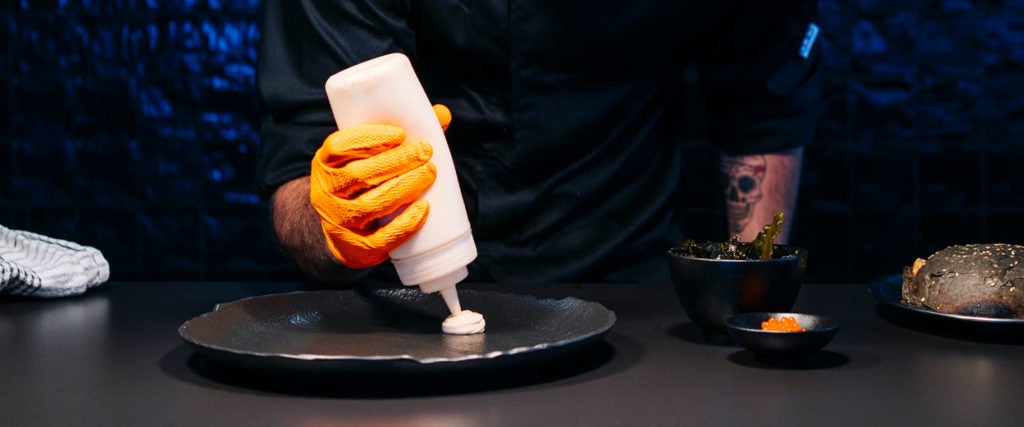You might imagine that someone who’s been cooking for 20 years would know how to operate a plastic grocery-store container of peanut oil by now. But those fine motor skills hit a brick wall yesterday as I attempted to lube up a cast-iron pan to make some hash browns.
As I tipped the container over to dose out three tablespoons, my thumb hit a slick patch. My attempt to regain control went awry, sending a cascade of peanut oil onto the stove. The container was slippery. The stove was slippery. My pan had too much grease. And at that moment, all I could think about were the four plastic squeeze bottles I threw away during my move from L.A. to San Francisco earlier this summer.
That’s the funny thing about squeeze bottles: You think you don’t need ‘em in the kitchen, but in reality, they improve almost everything about cooking, from the mundane to the five-star. Heck, Anthony Bourdain tried to call attention to this way back in the late 1990s, when he wrote his groundbreaking memoir Kitchen Confidential and showed us how the pros worked on a hot kitchen line.
“The indispensable object in most chefs’ shtick is the simple plastic squeeze bottle, essentially the same objects you see at hot-dog stands loaded with mustard,” he wrote. “Mask a bottom of a plate with, say, an emulsified butter sauce, then run a couple of concentric rings of darker sauce — demi-glace, or roast pepper purée — around the plate. Now drag a toothpick through the rings or lines.”
This is, well, a decidedly 1990s aesthetic when it comes to restaurant plating, but Bourdain’s point holds true: Every professional kitchen has squeeze bottles, whether it’s a diner or a three-Michelin-star joint. I would know, having worked as the proverbial kitchen bitch in my parents’ sushi restaurant for years as a teenager, cleaning and refilling squeeze bottle after squeeze bottle with canola oil, mayonnaise and ponzu sauce. I used to flip eagerly through the pages of the French Laundry cookbook during my breaks, staring at the perfect dots of sauce and daydreaming that I was filling bottles with, I dunno, goat-milk creme fraiche flavored with yuzu instead of Best Foods mayo.
But the value of squeeze bottles goes far beyond just making pretty plates with dots and swirls. It’s why I missed my squeeze bottles after dropping a container of oil while cooking hash browns. That peanut oil should never have been in that clumsy, awkwardly shaped supermarket container. It should’ve been in a slender squeeze bottle, ready to spurt out a perfect amount of oil in a pretty stream.
Got a bunch of vinegar bottles kicking around in the pantry? That’s a perfect candidate for squeeze bottles, which are easy to store and perfect for rapidly dispensing a shot of flavor into sauces and dressings. Speaking of, homemade salad dressing becomes so much more convenient when kept in a squeeze bottle, as do taqueria-style salsas, pesto aioli, pumpkin spice syrup and anything else that you want to drizzle. Unlike jars and glass bottles, the reliable squeezie is lighter and easier to neatly fit into the door of a fridge or inside a cramped pantry. You can portion out bulk items, like cooking oil, and keep the bigger container in a closet somewhere.
The uses extend beyond the home kitchen, too — when I go camping, I bring things like diluted dish soap and even whiskey in squeeze bottles, making it leakproof with a bit of plastic wrap stretched between the mouth of the bottle and the screw-on spout.
And, of course, there is the aforementioned Fancy Shit®, and without a doubt, the versatile squeeze bottle deserves credit for its ability to turn a white plate into a bit of Joan Miró-esque art. Look at the frenetic squeeze-bottle magic that happens every night at a Joel Robuchon restaurant. I’m sure this footage will give some of you an anxiety attack, but for me, it looks like bliss:
Such forays into fine-dining excess really aren’t that difficult to replicate at home, as long as you have the right squeeze bottles and an eye for pretty design. Like Bourdain noted, it looks pretty nice when you spoon one sauce onto the center of a plate and then use a squeeze bottle to border it with a contrasting sauce, like I did for this steak dinner:
It’s also great for sauces that have more texture and structure, like this puree of sun-dried tomato and Korean gochujang I dotted onto a slab of crisp trout. Studies show the appearance of a plate of food directly impacts how we perceive its taste, and for me, these little weeknight forays into aesthetic cookery help brighten my mood, even if it’s as simple as, well, squeezing a bottle.
Some final tips: Use a kitchen funnel for messier/hot fill jobs, and wipe down the plastic bottles frequently, because they can get sticky if you’re not careful (I even like to loop a piece of napkin with a rubber band on my oil bottles, because little dribbles often run down from the tip). Make sure to label each bottle with the contents and date of the ingredients, like a pro, for easy finding. As for the best bottles to buy? I like a medium-size one as an all-purpose vehicle, and a few small bottles for tinier batches (as with the green herb oil I used on the steak mentioned above). Cook’s Illustrated recommends these after testing, and while that’s what I’ve ordered, it doesn’t really matter too much. Just go to a restaurant supply shop near you, if you want to buy local.
Food can often feel like a compromise of function and form, but the squeeze bottle is the rare tool that’s as practical as it is precise. Living for months without mine made me realize how badly I miss them — and I think you’ll come to adore this humble plastic tool, too.

